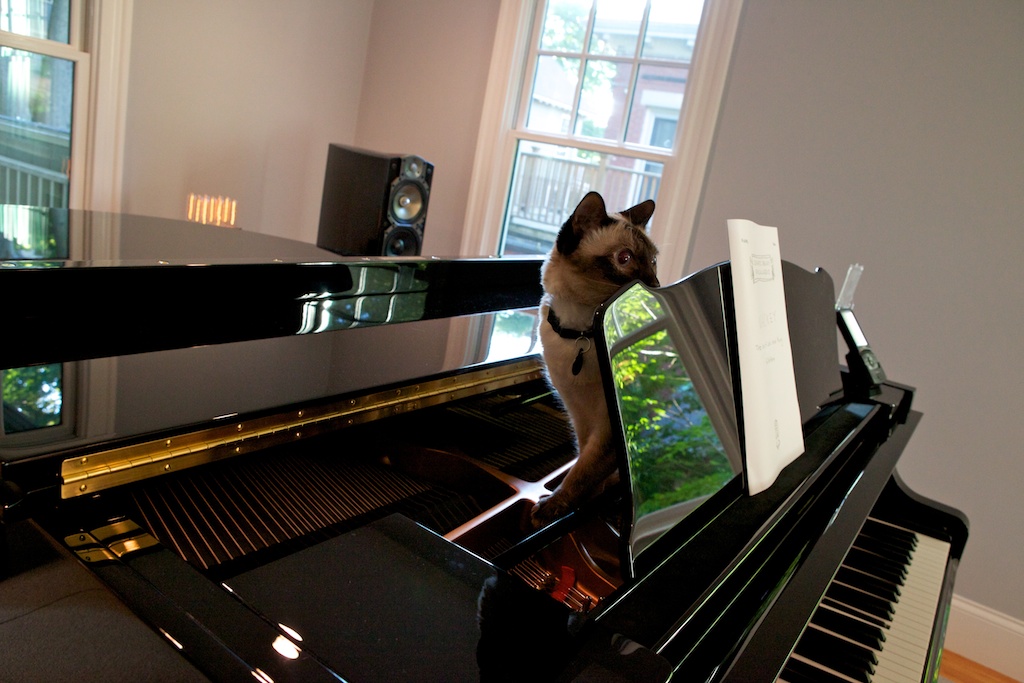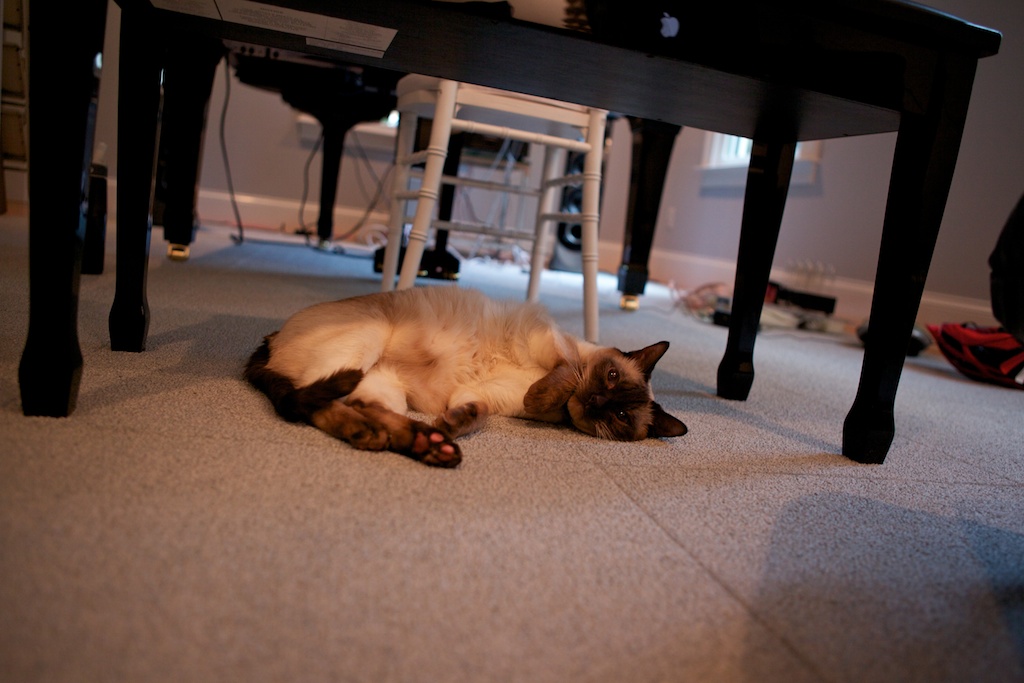July 21, 2011
Disklavier
I’m not a good pianist. I’ve said before that I play piano like a bad typist types. I can find chords, but I can’t “play.” Through undergrad, though, I wrote all of my music at a digital piano (now passed on to our friend Liz Love), and my music was frequently more lyrical, probably because if I was going to be able to play anything at all, it would, out of necessity, be slow music.
As my sample library improved, I wrote more and more exclusively at the computer, where my primary interface was a computer keyboard, and the MIDI keyboard became secondary. I also stopped playing “at” the piano because my setup, out of necessity, prevented the piano from being played comfortably, as you can see from this picture of my studio in NY:
The digital piano remained on my desk through my time in LA and Austin. Here’s a shot of the former Austin studio:
As you can see, the keyboard really functioned as a MIDI controller, not an “instrument,” since the position is all wrong, and there aren’t even traditional pedals.
Last summer, I sublet a place in NYC, and that apartment had an upright piano. I wrote one piece on that piano — a piece that, not surprisingly, was the most lyrical piece I’d written in years: Hymn to a Blue Hour. I decided, after playing that (out-of-tune, upright) piano for about 10 minutes, that I needed my own piano.
That was the only thing I really wanted to accomplish with our new house in Cambridge: to find a place where I could have my first real piano. As for the specific instrument, I knew I wanted a Yamaha — they produce my favorite piano sound — and I wanted it to be not just a piano, but also serve as my MIDI controller. Enter the Disklavier.
Literally our second day in Cambridge, I ordered the Yamaha DC3M4. This is just a Yamaha C3 grand piano – a very nice piano to begin with – with Disklavier built-in.
As a side note, Yamaha makes all kinds of stuff besides instruments. They also make motorcycles. This is not the Yamaha C3 I bought:
The Yamaha Disklavier is, first and foremost, a traditional piano, with strings, hammers, and pedals. But hidden inside and underneath the instrument is some amazing Linux-based technology that allows the piano to record what you play and send it as MIDI data to your computer, just like any synth would. This is accomplished without changing the touch of the piano at all, as the sensors are entirely optical, so nothing (other than light) is making physical contact with the keys. Like an oldie-time player piano, the Disklavier can play back that same data, moving the keys and pedals as it plays. The piano even has a “silent mode,” which blocks the hammers from the strings, and instead sends the sound through headphones or MIDI alone. Again, the touch isn’t changed, so it feels the same whether or not the piano is in silent mode, but this allows you continue to play at any hour of the day or night without being concerned about noise (or anybody hearing how badly you play).
The piano arrived while I was at Interlochen a few weeks ago, so I got home to find it already set up. And, knowing about my large collection of those Schirmer Library of Musical Classics…
… AEJ had this waiting on the piano. If you meet somebody who does something like this for you, you need to marry them.
The piece is really pretty good. I particularly like the use of 5/8+4/8, followed by 5/8+3/8. I may use that in the upcoming Percussion Concertino.
I loved the piano at first sight. Loki, on the other hand, was unsure.
He totally didn’t understand its ability to play itself.
It did at least provide some good spots from which to peek.
And it’s not a bad place to lounge, either, at least when it’s not banging away.
While photos are great, something like this demands video. So, here is a short video of Finale 2008 playing an excerpt of the piano part from “Breakdown Tango,” which was the original version of “Redline Tango.” The sound isn’t great — the actual volume in the room was loud as hell — but you’ll get an idea of what the Disklavier does. The best part of the video is the first frame, which shows the bandaids all over my hand from the injuries I sustained during a bike crash the other day. (More on that in the near future, but in the meantime, if you live in a major city, and you park on the street, you might want to check your side view window before opening your door.)
Comments
Michael Reed says
Great entry, John!
I enjoyed the writing, the photos, and the video of the piano!
What a special gift you found waiting on your piano!
Best,
Michael
Keri says
That's the coolest piano I've ever seen! I'm looking forward to hearing what it inspires you to write next.
Keri
Hannah Carlson says
You should link your house alarm to the piano when you're out of town so if someone dares to break in they'll find a piano playing itself. I know that would scare the hell out of me if I walked into an empty house and found that.
Kevin says
Why would you spend $50,000+ on a piano if you can't play it very well? Did you win the lottery?
Tyler says
Who the hell still uses Finale 2008?!
Christian Sweatt says
Love the blog - photos, video, story! Can't wait to hear all the great pieces you'll compose with your new piano at your side. How exciting!
Incidentally, I'm going to come steal your cat! haha I've been wanting a cat like yours for the longest time, and actually started looking two weeks ago. No luck so far.
All the best!
Rain Martin says
If somebody put The Firebird, Petrushka, and The Rite of Spring on my brand new piano, I'd marry them in an instant.
Heck, even if they just put The Rite of Spring on it I'd marry them! And I'm 16!
Add comment